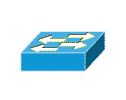Devices
Configs
The Switch
 The switch is the central point of the LAN (Local Area Network). The switch is called a layer
2 device. The network is often described as a stack of layers. Layer 1 is the physical
part of the network which includes NICs (Network Interface Cards) and cables. Layer 2 is
where the Ethernet protocol is used. Every network device has a unique MAC address and
devices know how to send and receive Ethernet frames to each other on the same LAN.
The switch is the central point of the LAN (Local Area Network). The switch is called a layer
2 device. The network is often described as a stack of layers. Layer 1 is the physical
part of the network which includes NICs (Network Interface Cards) and cables. Layer 2 is
where the Ethernet protocol is used. Every network device has a unique MAC address and
devices know how to send and receive Ethernet frames to each other on the same LAN.
The switch provides everything the older hub provided such as signal regeneration and more. A switch is much smarter than a hub and it can remember which MAC addresses it hears on each of its ports. It then uses that information to filter frames to only go where they should. Switches also allow full duplex operation so that devices attached to one of its ports can send and receive frames at the same time. The full duplex operation and filtering eliminate Ethernet collisions and allows better performance overall than the older hub based networks.
Switch technology also includes VLANs, spanning tree protocol and security. VLANs let the administrator group ports together into a virtual LANs that are separate. It is as if each VLAN was a separate network connected by a separate switch. This is useful if you want to contain confidential traffic. Spanning tree protocol eliminates network loops. A network loop is like a PA sound system and someone puts the microphone to close to the speaker which results in an ear splitting shriek. This can happen on a network too if frames are end up back at the same port that originally sent it. Port security provides controls on switch ports to restrict MAC addresses.



